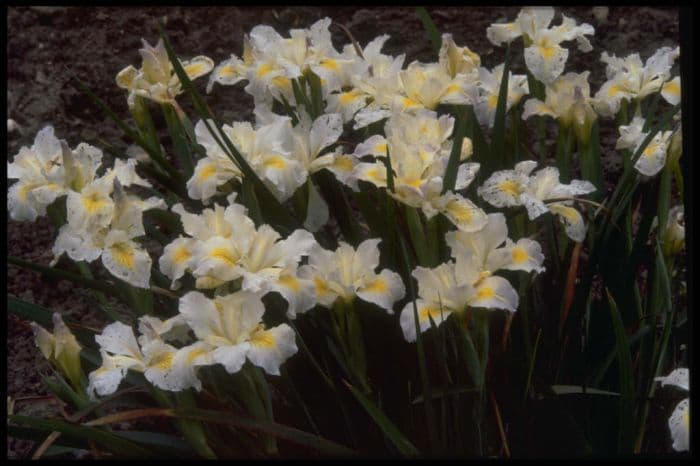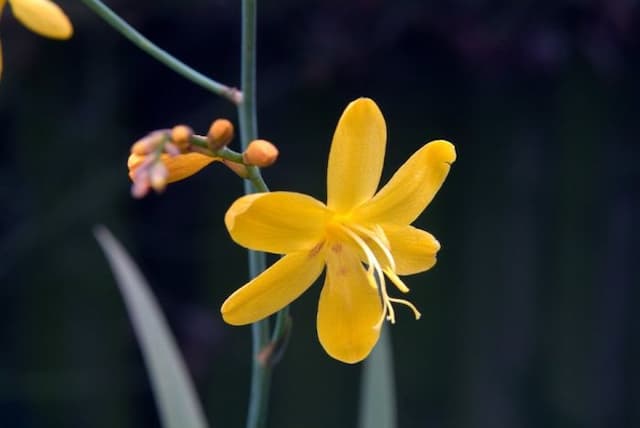Orris Iris 'Arnold Sunrise' (CH)

ABOUT
Iris 'Arnold Sunrise' is characterized by its strikingly beautiful flowers that exhibit a diverse palette of colors. Each flower is composed of several petals that often feature a gradient of hues ranging from deep yellows at the base to a soft, creamy color towards the edges. This warm tonal transition gives the blooms a sunny appearance, as if capturing the essence of a sunrise. The contrast is further enhanced by occasional delicate veining or speckles, adding to the visual interest of each petal. These flowers are typically comprised of three upright petals known as standards, coupled with three downward-arching petals referred to as falls. The falls may sometimes display a distinct beard-like feature in a bright or complementary color, which adds a touch of drama and draws pollinators. The foliage of Iris 'Arnold Sunrise' consists of long, slender leaves that are sword-shaped, with a rich green color that provides an elegant backdrop to the vivid flowers. These leaves are arranged in a fan-like pattern, emanating from the base of the plant and giving it an organized, vertical structure. The striking contrast between the bold foliage and the delicate, ornate flowers makes this iris a captivating addition to any garden space. The overall appearance of the plant exudes a classic charm, with the blooms providing a focal point of radiant color that is sure to attract the attention of onlookers and admirers during its flowering season.
About this plant
 Names
NamesSynonyms
Arnold Sunrise Iris
Common names
Iris 'Arnold Sunrise' (CH).
 Toxicity
ToxicityTo humans
Iris 'Arnold Sunrise' is a cultivar of the common iris. Irises contain compounds that can be toxic if ingested by humans. The rhizomes (underground stems) of irises contain the highest concentration of these compounds, such as irisin, iridin, or irisine which are glycosides. If a person ingests part of an iris, they may experience symptoms including stomach pain, nausea, vomiting, and diarrhea. In severe cases, this could lead to dehydration due to prolonged vomiting and diarrhea. Handling the plant may, in some cases, cause skin irritation due to the presence of certain iridoids.
To pets
Iris 'Arnold Sunrise' is a variety of the common iris, which is potentially toxic to pets if ingested. The plant’s rhizomes are particularly toxic due to the presence of compounds such as irisin, iridin, or irisine, which can induce gastrointestinal distress. Symptoms of poisoning in pets can include drooling, vomiting, diarrhea, and abdominal pain. Ingesting large quantities of the plant could potentially lead to more serious conditions such as lethargy and depression. It's important for pet owners to keep their animals away from irises to prevent accidental ingestion.
 Characteristics
CharacteristicsLife cycle
Perennials
Foliage type
Deciduous
Color of leaves
Green
Flower color
Mixed
Height
2-3 feet (0.6-0.9 meters)
Spread
1-2 feet (0.3-0.6 meters)
Plant type
Bulb
Hardiness zones
3-9
Native area
Northern Hemisphere
Benefits
 General Benefits
General Benefits- Attractive Blooms: The Iris 'Arnold Sunrise' produces vibrant, colorful flowers that add beauty to any garden setting.
- Low Maintenance: Once established, irises generally require minimal care aside from occasional watering and dividing of clumps.
- Drought Tolerance: These plants are quite resilient and can tolerate periods of dry weather, making them suitable for various climates.
- Long Bloom Season: Irises have a relatively long flowering period, providing visual interest throughout the season.
- Pest Resistance: The Iris 'Arnold Sunrise' is known to be resistant to many common garden pests, reducing the need for chemical treatments.
- Variety of Uses: They can be used in a variety of landscapes, including borders, beds, and as cut flowers to brighten up indoor spaces.
- Adaptable: These plants can adapt to a range of soil types, although they prefer well-drained soil.
- Attracts Wildlife: The colorful flowers can attract pollinators such as bees and butterflies to the garden, which is beneficial for plant health and biodiversity.
- Erosion Control: The strong root systems of irises can help stabilize soil and prevent erosion in certain settings.
- Seasonal Interest: Irises provide seasonal interest with their attractive foliage, even when not in bloom, adding to the plant's appeal throughout the year.
 Medical Properties
Medical PropertiesThis plant is not used for medical purposes.
 Air-purifying Qualities
Air-purifying QualitiesThis plant is not specifically known for air purifying qualities.
 Other Uses
Other Uses- Iris 'Arnold Sunrise' can serve as a natural dye source; different parts of the plant may yield unique colors when used for fabric or paper dyeing.
- The fibers of the Iris can be used in traditional paper-making processes, providing a distinct texture and strength to the paper.
- In some cultures, dried Iris petals are used in potpourri mixtures to add fragrance and aesthetic appeal.
- The sturdy leaves of the Iris can be woven into small baskets, mats, or even used in thatching for miniature decorative roofs.
- Artists may use Iris 'Arnold Sunrise' for botanical drawing or watercolor practice, capturing the form and color of the intricate blooms.
- Its pronounced flowers can be used as a natural stencil for arts and crafts, laying the flower on a surface and sponging paint around it to create a silhouette.
- Edible varieties of Iris petals, such as the 'Arnold Sunrise,' are sometimes candied for use as unique and elegant cake decorations.
- The plant can be incorporated into environmental education programs, demonstrating plant growth, pollination, and lifecycle to students.
- Iris 'Arnold Sunrise' can be used in photography as a subject for macro photography, showing the intricacy of its flower structure.
- The blooms can also serve as a natural pH indicator in science experiments, changing color in the presence of certain chemicals.
Interesting Facts
 Feng Shui
Feng ShuiThe Iris is not used in Feng Shui practice.
 Zodiac Sign Compitability
Zodiac Sign CompitabilityThe Iris is not used in astrology practice.
 Plant Symbolism
Plant Symbolism- Hope: Irises often symbolize hope, signaling the arrival of spring and the hope for warmer days ahead.
- Purity: The delicate nature and clean lines of the iris can represent cleanliness and purity in various cultural contexts.
- Wisdom: The iris is connected to wisdom and cherished for its role in the Greek mythology as the goddess Iris linked the gods to humanity.
- Royalty: The regal appearance of irises has led them to be associated with royalty and noble values.
- Valor: The flower's name traces back to the Greek word for rainbow, denoting the idea of bridging earthly and heavenly realms, resembling valor and bravery.
- Faith: Irises are often motifs in religious contexts, indicating faith and belief in higher powers or the divine.
 Water
WaterThe bearded iris, including the Iris 'Arnold Sunrise', should be watered thoroughly once a week, providing about one gallon of water per plant. It's crucial not to over-water as these plants prefer well-draining soil and can be prone to rot if kept too wet. During periods of drought or extreme heat, increase watering frequency to every 4-5 days but always check the soil moisture first — it should be dry an inch below the surface before watering again. Adjust the watering schedule based on rainfall, ensuring the iris isn't sitting in waterlogged soil.
 Light
LightBearded irises like the Iris 'Arnold Sunrise' thrive best in full sun. They need at least six hours of direct sunlight each day to bloom well. Plant them in a spot that receives full sun exposure throughout the day for optimal growth and flowering. Avoid placing them in areas with a lot of shade or where buildings or trees will cast shadows on them for significant parts of the day.
 Temperature
TemperatureThe bearded iris, such as Iris 'Arnold Sunrise', prefers temperate climates with temperatures ranging from 75°F to 90°F during the growing season. They can withstand cold winters down to about -20°F but should be protected from extreme cold with mulch or other insulation. The ideal growing temperatures for these irises will be between 55°F and 75°F to promote healthy growth and abundant blooms.
 Pruning
PruningPruning bearded iris plants like the Iris 'Arnold Sunrise' is mainly about removing the spent flower stalks after blooming and trimming away any damaged or diseased leaves. This helps to prevent disease and encourages more blooms for the following year. Pruning should be done annually, usually immediately after the blooming period. Additionally, every 3-4 years, the plants should be divided in late summer to maintain vigor and flower quality.
 Cleaning
CleaningAs needed
 Soil
SoilThe bearded iris, including 'Arnold Sunrise', thrives best in well-draining soil with a neutral to slightly acidic pH of 6.8 to 7.0. A good soil mix for these irises would include loamy garden soil, compost, and coarse sand to improve drainage. Avoid heavy clays and stagnant water conditions to prevent rhizome rot.
 Repotting
RepottingBearded irises, like 'Arnold Sunrise', typically do not need frequent repotting and are best divided and replanted every 3 to 5 years. This encourages rejuvenation and increases blooming potential. Division should be done after flowering, usually in late summer.
 Humidity & Misting
Humidity & MistingBearded iris 'Arnold Sunrise' tolerates a wide range of humidity levels but thrives in moderate conditions. While specific humidity levels aren't crucial, it is important that the rhizomes are not in overly humid conditions which can lead to rot.
 Suitable locations
Suitable locationsIndoor
Ensure bright light, good air flow, and avoid water stagnation for indoor bearded iris.
Outdoor
Plant in sunny spot with well-draining soil and space rhizomes apart.
Hardiness zone
3-9 USDA.
 Life cycle
Life cycleThe Iris 'Arnold Sunrise', commonly known as Bearded Iris, starts its life as a dormant rhizome which, when planted in late summer to early fall, roots and establishes itself in the soil. In the spring, new growth emerges, and fans of sword-shaped leaves begin to grow. By late spring to early summer, flower stalks extend upwards, culminating in the blooming of distinctive, colorful flowers that attract pollinators. After the flowering period, the plant goes into a phase of vegetative growth, where it strengthens its root system and stores energy for the next season. In the fall, the plant starts to go dormant, with the foliage dying back, preparing the rhizome for overwintering. The cycle resumes the following spring, with the rhizome potentially giving rise to new offsets that can be divided to propagate new plants.
 Propogation
PropogationPropogation time
Spring-Early Summer
The most popular method of propagation for the Iris 'Arnold Sunrise' is through division, which is ideally done in late summer after the plant has finished blooming. To propagate by division, the gardener should carefully dig up the clumps of iris plants and gently separate the rhizomes by pulling or cutting them apart. Each section should have at least one fan of leaves and firm, healthy roots. The divisions are then replanted at the same depth they were growing at previously, spaced about 18 inches (approximately 45 centimeters) apart to allow for ample growth. It is crucial to water the newly planted divisions well to help establish them. This method is preferred as it also helps to rejuvenate older plants that may have become too crowded, and it allows for the steady increase of iris plants in the garden.









